Squat Foot Placement: Proper Foot Position Explained
Author:
Reviewed by:
(21 years of Oly Lifting experience)
Unlock your full potential by engaging with our experts and community! Have questions about your fitness journey or looking for expert advice on weightlifting techniques? Don’t hesitate — leave a comment below and Jason Li will provide a personalized answer and insights to help you reach your goals.
Torokhtiy is reader-supported. Some links are affiliate links, and we may earn a commission at no extra cost to you. See our disclosure page for details.
Squats are an exercise many love, but are you knowledgeable about squat foot placement? Correct foot placement for squats can help reduce the risk of injury and aid in targeting certain muscles during different squat variations.
What is the best squat foot placement?
Squat foot placement can change depending on the type of squat you are performing, and the muscles you intend on stressing during the movement. Lifting with your feet shoulder-width apart, closer together, and considerably wider are all potential foot positions for squats depending on the squat variation.
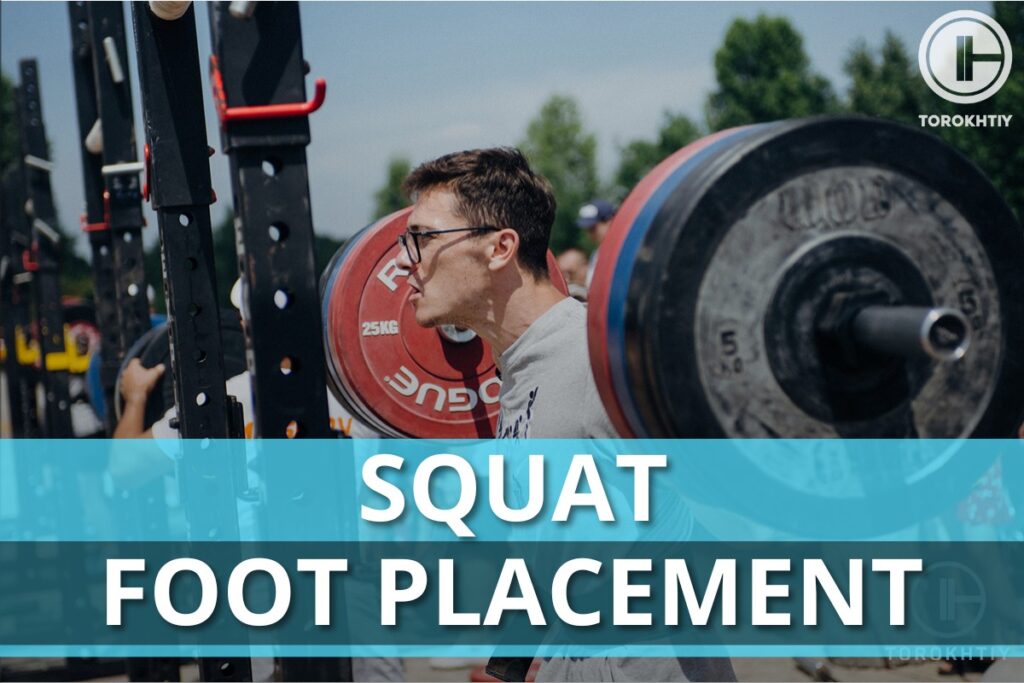
Why Is Foot Placement Important During Squats?
Lifting with correct form is vital across all aspects of weight training, and feet position for squats is part of this. There isn’t just one way to perform a squat, and with many variations of the movement, it’s essential to know where and how you should be placing your feet.
1. Creates Stability
Feet form the foundation of a squat as they create the baseline of stability from the ground up. Your squat foot position will change depending on the squat variation you’re performing, but regardless of positioning, the feet need to be planted to create stability. Unstable feet during a squat can lead to poor form, and can negatively impact your lift by making you unsteady.
🔻GET A FREE PROGRAM DEMO: 12 Week Squat Program by Oleksiy Torokhtiy
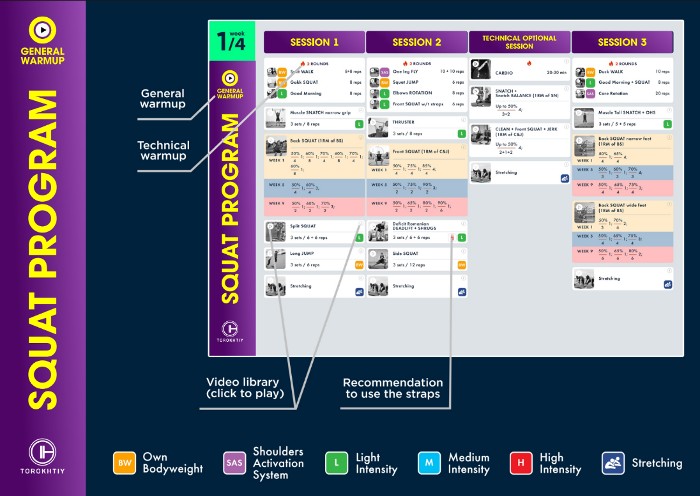
Do you want to double your squat strength? In just 12 weeks, you’ll be able to boost your squat results.
Enter your details and get a free demo (1 free week) of the squat program straight into your inbox.
2. Protects Knees
Alongside stance, foot placement for squats can impact the movement in the knee joint. By placing your feet at an appropriate angle and distance apart, you can help avoid injury that may occur from repeatedly squatting in extreme positions. Your knees shouldn’t turn in when squatting as this puts unnecessary pressure on the joint, so foot placement is key.
3. Can Affect Lifting Ability
The choice you make in squat foot placement and squat leg position can affect how much weight you’re lifting. Sumo squats generally focus more of the load on the inner thigh and glutes, as they are more of a hip-dominant movement compared to traditional squats. This can lead to some being able to lift heavier with sumo squats, but this depends on the individual anatomy and ability of the lifter.
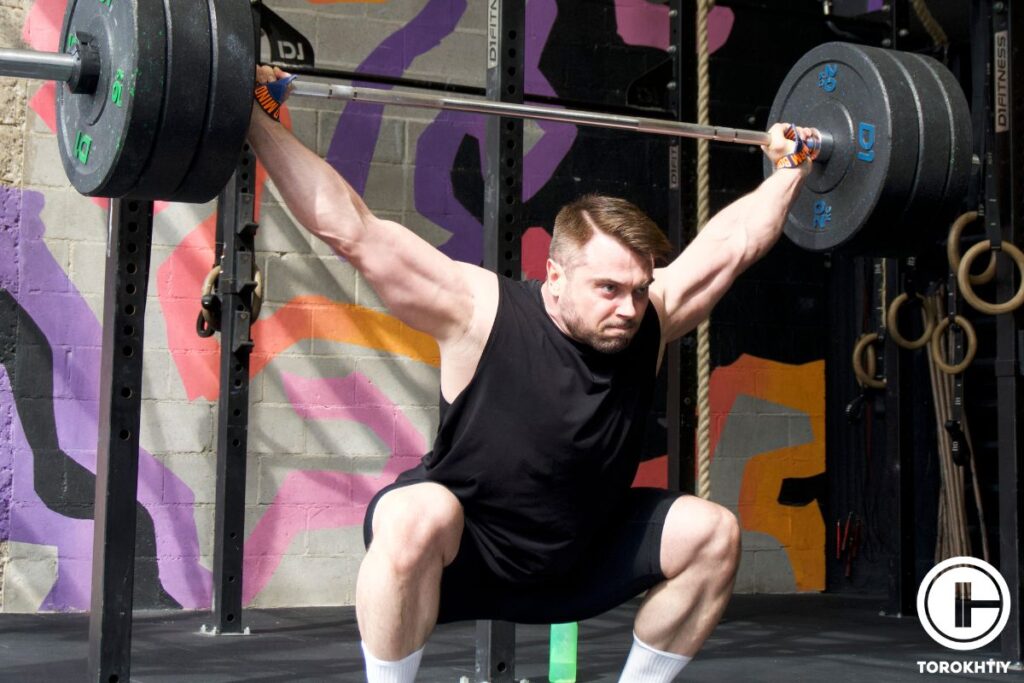
4 Factors Influencing Foot Placement While Squatting
Several factors can influence foot placement while squatting, and exploring them in more depth is a great way to better your understanding of squat foot placement.
1. Stance Width
The type of squat you perform can change your stance width considerably. Conventional back squats entail a shoulder-width squat foot position, while sumo squats require a wider stance with your feet set further apart. Squatting with a large width can result in greater activation of the gluteus maximus during a conventional back squat, so wide stance squats are an ideal exercise to incorporate into your training if strengthening glutes is a goal for you.
2. Hip Anatomy
Just as our skeletons are different from one another, so is our hip anatomy, and this can affect barbell squat feet position alongside other squat variations. Hip anatomy can affect squat mechanics as those with shallow sockets are more likely to find achieving squat depth easier than those with deeper sockets. This can lead to squat on toes where some individuals may only be able to complete a deep squat if their knees stick out over their toes slightly.
Follow us!

Free!
Get a 2-week Weightlifting Program as a bonus for the subscription to kickstart your training plan!

Free!
3. Squat Variation
Performing different types of squats can have a large effect on where you place your feet. Regardless of the style of squat you’re doing, it’s essential to keep some degree of your toes turned out. It’s normal for this angle to vary between lifters, but the most important thing is to ensure your knees aren’t rolling inwards. This is important whether you’re doing a traditional back squat, goblet squat, sumo squat, overhead squat, or other variation.
4. Footwear
It’s common to see various types of footwear in the gym, from flat-soled trainers and weightlifting shoes to people lifting without shoes at all. Squat leg position affects where you place your feet, but so does the type of footwear you’re wearing. Studies have shown that wearing weightlifting shoes activates areas of the ankle which in turn leads to better balance performance.
Tips From the Champ
If you don’t currently own any weightlifting shoes, this effect can be replicated. By wearing flat-soled shoes or going barefoot, you can elevate your heels slightly with a small lifting plate or similar.
Olympic Weightlifting Champion
What Is The Optimal Foot Placement For Squats?
The ultimate squat foot position can vary depending on anatomy, squat type, stance, and more. Optimal foot placement for squats depends on personal ability and the style of squat you are performing, but I’ve put together some tips so you can assess your form and try to avoid a squat on toes.
1. Shoulder Width
A squat foot placement of shoulder width apart is a good baseline for a conventional squat, where feet should be planted on the ground, providing balance and stability. During execution, the goal is for body weight to be distributed through the foot, with more weight toward the back of the foot to support the hips during the squat.
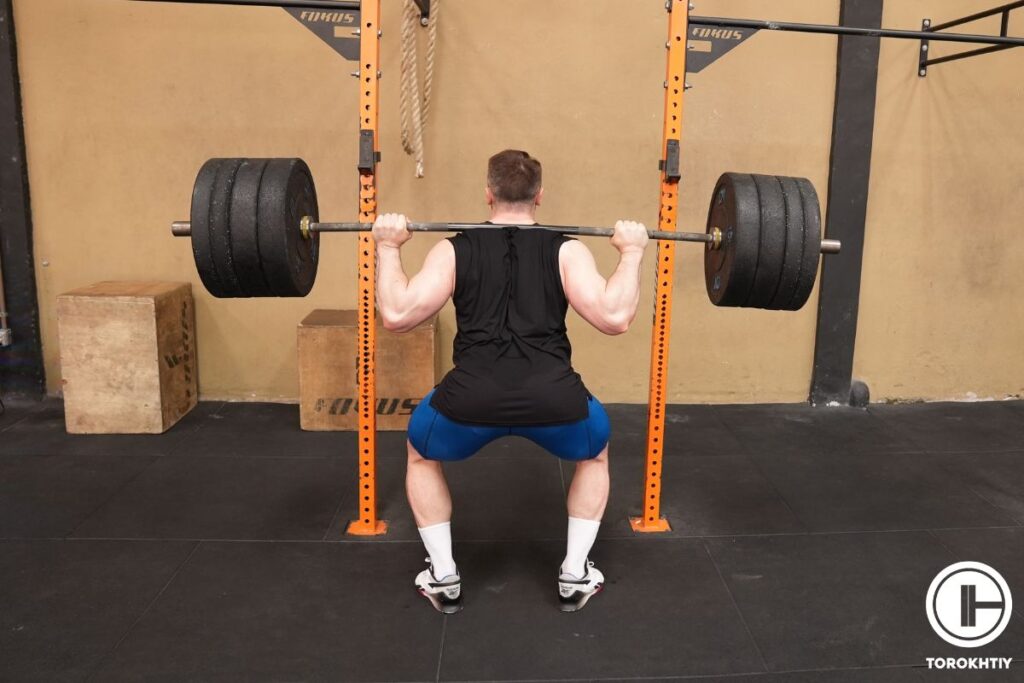
2. Close Together
Unlike a sumo squat which recruits more from the glutes, a narrow stance squat targets the quads more. Adopting a stance where the feet are close together is great for those wanting to build lower body strength and hypertrophy. As a wide stance can affect muscle activity with the thighs and buttocks, a narrow stance may be a better position for those with lower hip ROM.
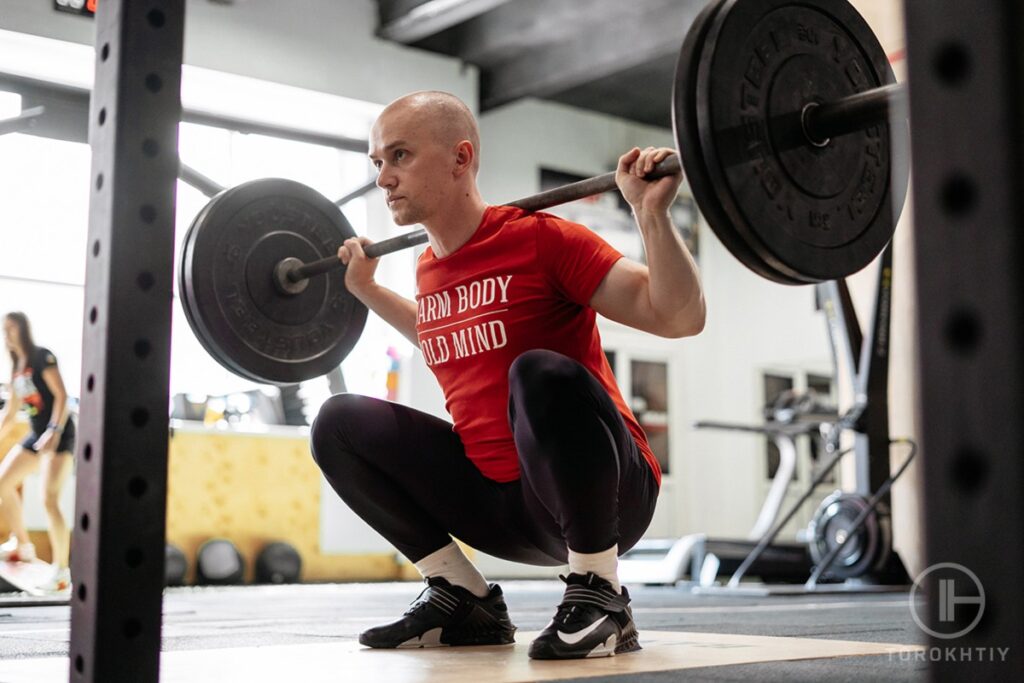
3. Wide
For a wide squat stance, the feet should be wider than shoulder-width apart, with the toes slightly turned out which should help keep the knees from rolling inwards. When adopting a wide stance, it’s essential to not make the stance too big, as this can lead to a lack of stability and balance when performing the exercise.
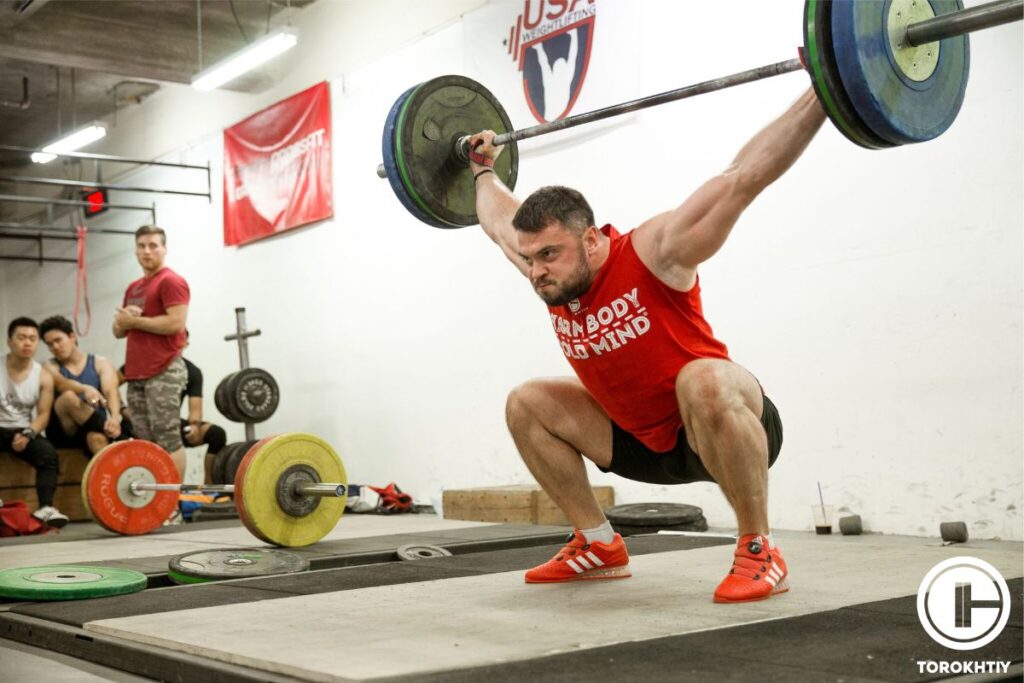
Narrow vs Wide Feet Placement While Squatting: Key Differences
| Narrow Squat Foot Position | Wide Squat Foot Position |
|---|---|
| More recruitment from quadriceps and hamstrings | More activation from adductors, inner thighs, and gluteus maximus |
| Can be difficult to achieve depth with a narrow squat | Easier to achieve depth for those with good hip ROM |
| Narrow stance makes it easier to stop knees from turning inwards | Can be difficult to stop knees rolling inwards due to a widened stance |
3 Mistakes With Foot Placement When Squatting
Working out the optimal foot placement for squats can take time and a closer look at your body. Once you’ve learned the correct form, you can perfect your squats and help avoid some of the common mistakes I regularly see with foot placement during squatting.
1. Feet Rolling In
When squatting, keeping your feet planted on the ground is vital, as the feet are what anchor the body during the movement. Lifting with a stable foundation is key for successful training and reducing the risk of injury, so ensure your feet are planted and your feet don’t roll in (often followed by your knees).
2. Heels Rising Off The Ground
Lifting your heels off the floor during a squat isn’t wise, as it can lead to a lack of stability along with weight shifting forwards into your knees. Wearing weightlifting shoes or elevating your heel can be a great way of bettering balance and can also improve knee engagement during a barbell squat.
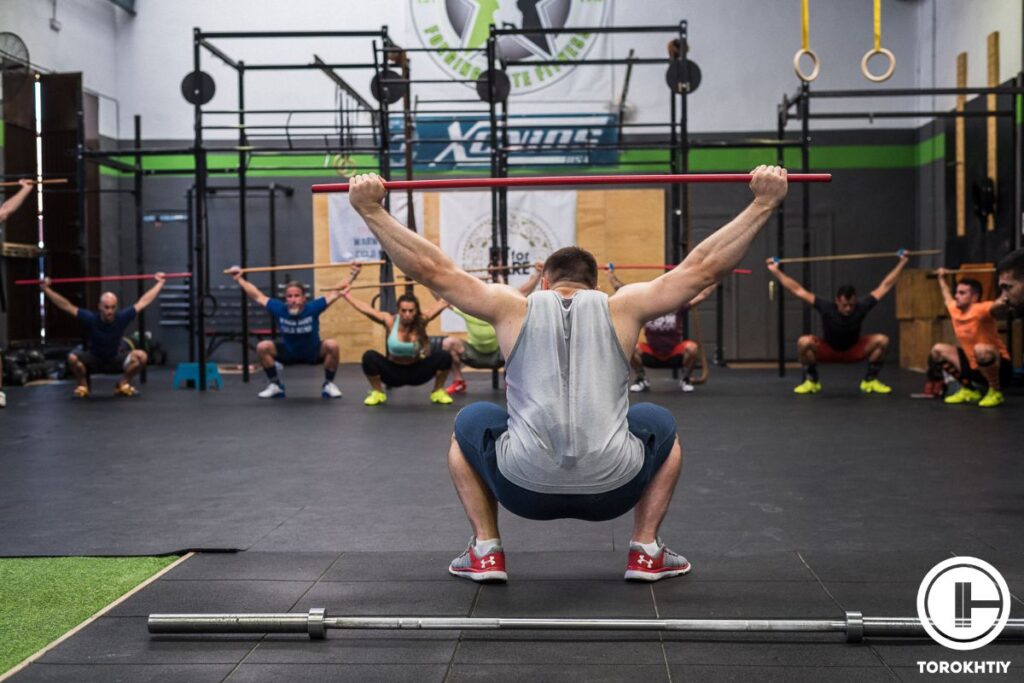
3. Pointing Feet Inwards
Pointing the feet slightly outwards is a common practice for squats, as it allows for increased depth alongside lower injury risk in the ankles and knees. Pointing the feet inwards means it’s far more likely you will also turn your knees inwards, which is better to avoid in case of injury.
FAQ
Does Foot Placement Matter For Squats?
Foot placement matters for the correct execution of various squat types. It can, however, vary substantially from person to person, due to hip anatomy, squat variation, and the lifter’s ability. By performing a squat with the right foot placement, you can target muscles differently, remain stable and balanced, and even achieve a better squat overall.
Is It Better To Squat With Toes Forward Or Out?
When squatting, it’s vital to find a position that your body is comfortable with, and this can affect the squat foot position. Pointing the toes inwards is never an ideal position for squatting, but there’s a recurring debate about whether feet should face forwards, or be slightly turned outwards. Both of these positions are correct, but for most, turning the toes outwards leads to hip rotation and often a deeper squat position.
Conclusion
Squat foot placement is a broad topic with many possible discussions such as squat type, anatomy, individual capability, and more being a few I’ve touched on today. Finding the best feet position for squats means exploring various squat types, evaluating your ROM, and taking a closer look at how your body generally feels when completing the exercise.
What squat foot placement have you found to be most beneficial for your training? Let me know in the comments!
Also Read:
- What Muscles Do Squats Work? (Lifting Coach Explains)
- Lower Back Pain When Squatting: Causes & Fixes
- Leg Exercises For Bad Knees: Strengthening Your Legs Safely
- How Much Does A Squat Bar Weigh? Standards Explained
- Forearm Pain When Curling: Causes And Solutions
- Do Squats Make Your Butt Bigger? (Improve The Result)
- Butt Wink Causes & Fixes For Perfect Squat Form
Referenses:
- Silvio Lorenzetti, Mira Ostermann, Fabian Zeidler, Pai Zimmer, Lina Jentsch, Renate List, William R. Taylor & Florian Schellenberg, “How to squat? Effects of various stance widths, foot placement angles and level of experience on knee, hip and trunk motion and loading”, BMC Sports Science, Medicine and Rehabilitation, https://bmcsportsscimedrehabil.biomedcentral.com/articles/10.1186/s13102-018-0103-7 (Accessed February 7 2024)
- Antonio Paoli, Giuseppe Marcolin, Nicola Petrone, “The effect of stance width on the electromyographical activity of eight superficial thigh muscles during back squat with different bar loads”, National Center For Biotechnology Information, https://pubmed.ncbi.nlm.nih.gov/19130646/ (Accessed February 7 2024)
- Charlie Hoolihan, CSCS, “A Coach and Trainer’s Challenge – Individual Variables in Health, Fitness, and Nutrition”, National Strength and Conditioning Association,
https://www.nsca.com/education/articles/ptq/a-coach-and-trainers-challenge-individual-variables-in-health-fitness-and-nutrition/ (Accessed February 7 2024) - Joshua W. Cohen, Philip Lee, Jessa Buchman-Pearle, “The Effects of Footwear on Squat Movements”, University of Western Ontario, https://pdfs.semanticscholar.org/8860/3128c083f813662507a12b3bddef98aac73d.pdf (Accessed February 7 2024)
- Myer, Gregory D. PhD, CSCSD Kushner, Adam M. BS, CSCS Brent, Jensen L. BS, CSCS Schoenfeld, Brad J. PhD, CSCS, FNSCA Hugentobler, Jason PT, DPT, CSCS Lloyd, Rhodri S. PhD, CSCSD Vermeil, Al MS, RSCC*E Chu, Donald A. PhD, PT, ATC, CSCS, FNSCA Harbin, Jason MS McGill, Stuart M. PhD, “The Back Squat:
A Proposed Assessment of Functional Deficits and Technical Factors That Limit Performance”, Strength and Conditioning Journal, https://journals.lww.com/nsca-scj/fulltext/2014/12000/the_back_squat__a_proposed_assessment_of.2.aspx (Accessed February 7 2024) - S T McCaw, D R Melrose, “Stance width and bar load effects on leg muscle activity during the parallel squat”, National Center For Biotechnology Information, https://pubmed.ncbi.nlm.nih.gov/10188748/ (Accessed February 7 2024)
- Zhenghui Lu, Xin Li, Rongrong Xuan, Yang Song, István Bíró, Minjun Liang, and Yaodong Gu, “Effect of Heel Lift Insoles on Lower Extremity Muscle Activation and Joint Work during Barbell Squats”, National Center For Biotechnology Information,
https://www.ncbi.nlm.nih.gov/pmc/articles/PMC9312299/# (Accessed February 7 2024)
Why Trust Us?
With over 20 years in Olympic weightlifting, strength training, nutrition coaching, and general fitness our team does its best to provide the audience with ultimate support and meet the needs and requirements of advanced athletes and professional lifters, as well as people who strive to open new opportunities and develop their physical capabilities with us.
By trusting the recommendations of our certified experts in coaching, nutrition, and sports training programming, as well as scientific consultants, and physiotherapists, we provide you with thorough, well-considered, and scientifically proven content. All the information given in the articles concerning workout programming, separate exercises, and athletic performance, in general, is based on verified data.
The product testing process is described in more detail here.
Author: Jason Li
Personal Coach, Functional Range Conditioning Mobility Specialist
Jason is an NYC personal training expert and National level Olympic Weightlifting Coach with over 10 years of experience training everyday clients to high levels of performance. He has trained everyone from youth (13 years old and under) to masters (60+ years old) to regional and national rankings for powerlifting, Olympic Weightlifting, Short distance (up to 200m) sprinting, discus & hammer throwing.
Reviewed by: Oleksiy Torokhtiy
Olympic Weightlifting Champion, PhD in Sport Science
Best Results: Snatch – 200 kg,
C&J – 240 kg
Oleksiy Torokhtiy is a professional athlete boasting 20 years of experience in Olympic weightlifting. With multiple European and World titles under his belt, he has showcased his prowess in two Olympic Games (Beijing 2008 and London 2012). Upon concluding his illustrious career, Oleksiy dedicated himself to coaching. By 2022, he had conducted over 200 weightlifting seminars worldwide. He is the visionary behind an international sportswear and accessories brand known for its motto, “Warm Body Cold Mind.” Additionally, he is an esteemed author and the creator of a series of training programs and eBooks.





Still have questions after reading our article? Unlock your full potential by engaging with our experts and community! Don’t hesitate — leave a comment below and Jason Li will provide a personalized answer and insights to help you reach your goals.